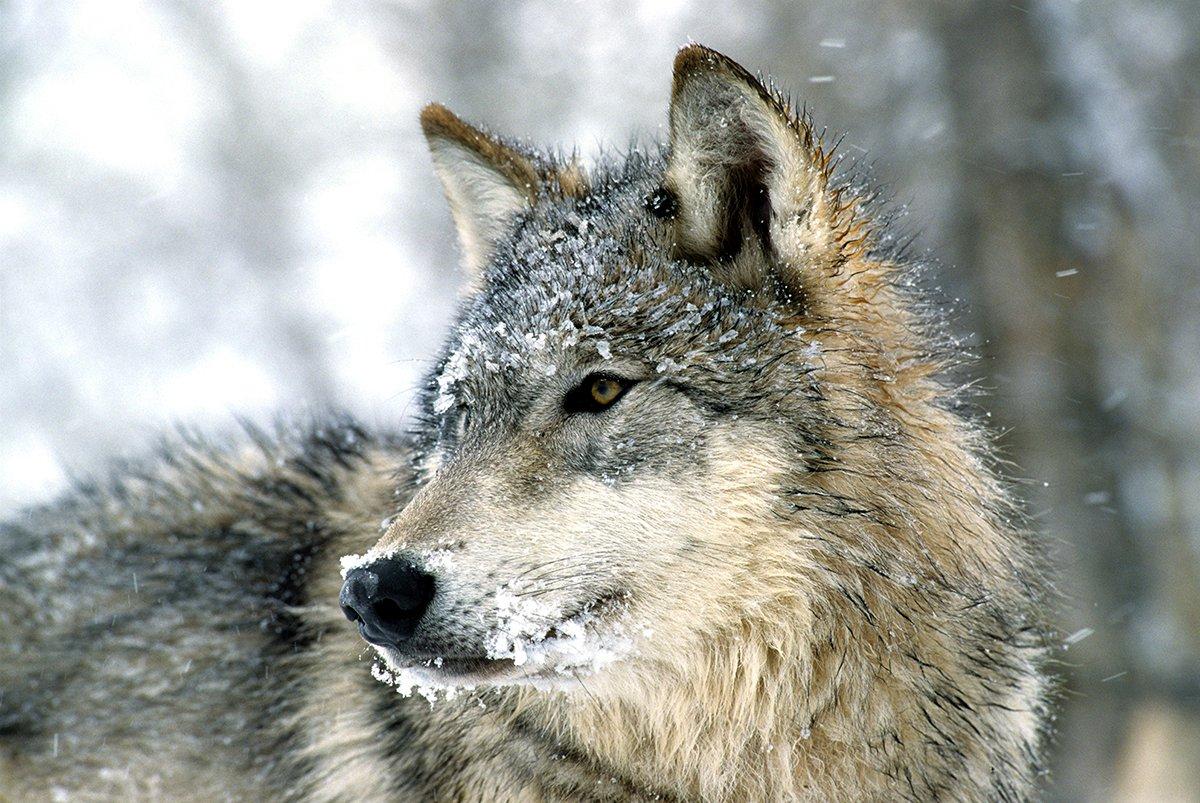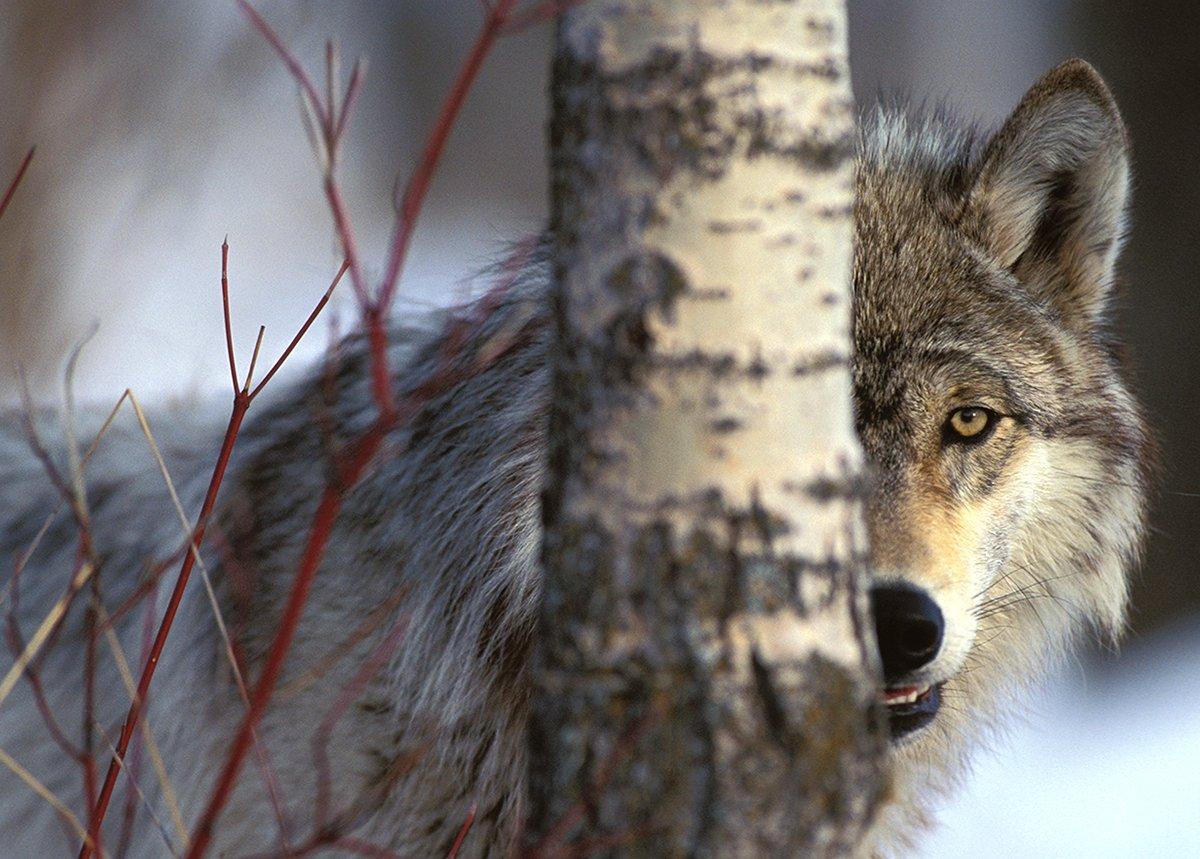A deep dive into one of the most controversial hunting discussions in America
Predator hunting is a popular pursuit during the winter and in some areas of the Rocky Mountains, that includes the opportunity to hunt the gray wolf. Gray wolf hunting and trapping seasons have been open on and off across Idaho, Montana, and Wyoming for the past decade. These elusive apex predators are difficult to pursue, but they provide an exciting opportunity for hunters, as well as the opportunity help wildlife management agencies keep populations in check.
Wolves trigger passionate emotions that lead to arguments both for and against hunting. And no matter how many years pass with wolf hunting seasons in place, they still make headlines with groups like the Humane Society of the United States and Defenders of Wildlife routinely pushing to have hunts shut down. Meanwhile, wildlife agencies maintain their positions that gray wolf populations are sustainable enough to not only warrant hunting seasons, but they want to enlist the help of hunters and trappers to keep wolf numbers in check.
The reintroduction of the gray wolf into the Rocky Mountains is a success story. When I was a child growing up in Montana, it was big news when gray wolves made their way back into Yellowstone National Park. The U.S. Fish and Wildlife Service reintroduced wolves into the park in 1995. During the reintroduction, the service transplanted 31 gray wolves from western Canada. I was 9 years old at the time. Every subsequent park visit was spent hoping I'd catch my very first glimpse of a wolf in the wild.
By the time I graduated college, the reintroduction was so successful that the population had grown and expanded beyond the park. Packs spread across Idaho, Montana, and Wyoming. Wolves began making their way onto ranches and creating conflict. This quickly moved into the court system, where there was even more conflict involving wolves.
Officials see their roles as being committed to the long-term survival of gray wolves while managing the population and addressing concerns with livestock and other big game. And they believe involving the help of hunters and trappers is crucial.
For nearly 15 years, agencies and organizations have argued over how to manage the West's wolves. Wolf populations in Idaho, Montana, and Wyoming have bounced back and forth between being on the Endangered Species List and being removed and placed under state management.
During my first TV reporter job in Missoula, Montana, I sat in the Russell Smith Federal Courthouse in 2009, listening to lawyers try to put an emergency stop to Idaho and Montana's first scheduled wolf hunts. Wildlife management agencies in both states had determined populations were strong enough to open limited hunting opportunities through a quota-based hunt. Mandatory reporting of any wolf kill within a 24-hour window would allow the agencies to shut down the hunt promptly to avoid over-harvesting. The U.S. Fish and Wildlife Service's wolf recovery effort had approved these plans.
(Don't Miss: Predator Hunts Gone Wrong)
As both a hunter and someone who enjoys the opportunity to see wolves in the wild, it was fascinating listening to both sides passionately argue their perspectives. Outfitters and ranchers argued the wolf population needed to be kept in check through regulated hunting because the predators were harming livestock and ungulate populations. Environmental organizations claimed the wolf population was still far too low and faced complete decimation by hunters.
At the time, the U.S. Fish and Wildlife Service estimated the Rocky Mountains' wolf population was over 1,600. Organizations opposing the hunts wanted populations upward of 5,000. Biologists argued that was too many for the landscape. I vividly remember listening to one woman testify in court that her dream was for her children to hear the howls of wolves from her backyard in the city.
Despite the ongoing legal battle, Idaho and Montana's first fair-chase wolf hunting seasons went ahead as scheduled in 2009. Montana wildlife commissioners set a statewide quota of 75 wolves, which they believed at the time was about 15% of the state's population. The Idaho Fish and Game Commission set a statewide harvest quota of 220 wolves.
It seemed like all eyes were on the West as opening day approached. With thousands of wolf tags being sold, environmental groups expressed fear that hunters would easily surpass those quotas on day one. But wildlife management agencies and hunters knew differently. Most wolves that aren't trapped are harvested opportunistically, meaning hunters with tags aren't targeting wolves, they just run into them while out hunting other species. When wolf season opened in Idaho, two wolf kills were reported on opening day. Montana reported one wolf harvest on its opening day. Montana officials closed wolf hunting after about two months, after 72 wolf kills were reported. Idaho extended its wolf hunting season before calling it quits in March 2010, with a total of 188 wolves killed. It never met the quota. Neither state allowed trapping that year.
In the years that followed that first season, wolves were delisted, trapping seasons opened, and Wyoming opened to wolf hunting. All the while, wolf populations grew and the legal battles continued. After more than a decade of wolf hunting across the West, it continues to make the news as something controversial. Environmental organizations maintain seasons threaten to destroy the population, and this rhetoric can lead to misleading headlines like the War on Wolves or New Idaho law allows killing up to 90 percent of state's wolves.
Wildlife management agencies continue to set seasons and quotas based on population estimates. They've also expanded different methods of take. Wildlife policy makers are clear on how they value the role of the gray wolf in the ecosystem. Officials see their roles as being committed to the long-term survival of gray wolves while managing the population and addressing concerns with livestock and other big game. And they believe involving the help of hunters and trappers is crucial.
If you're interested in going wolf hunting, here are the current opportunities available throughout the Rocky Mountains.
(Don't Miss: Tips for Nighttime Predator Hunters)
Idaho
Idaho gives hunters and trappers a lot of opportunities, including several units that are open to year-round hunting. Residents and nonresidents can purchase tags. There is no daily or season limit on wolves, but a person can't take more wolves than the number of legal tags they possess. Nonresident hunters can also use an unfilled nonresident deer or elk tag to harvest a gray wolf during the open season corresponding to the deer or elk tag hunt area or unit when gray wolf season is open.
Wolf tags purchased with a hunting license are valid for the calendar year. Wolf tags purchased with a trapping license are valid for the trapping year, July 1 - June 30. A person must attend a wolf trapper education class and have a valid trapping license before trapping for wolves.
Idaho doesn't have a quota for wolves. After seven years without reaching the quota, the state got rid of it in 2017. However, hunters and trappers must report kills so the state does keep an eye on the harvest statistics. The Idaho Department of Fish and Game's most recent estimate is that there are about 1,560 gray wolves in the state.
For more information review Idaho Fish and Game's current regulations.
Wyoming
The Wyoming Game and Fish department classifies gray wolves in two ways, depending on their physical location in the state. In the northwest part of Wyoming, the gray wolf is designated as a trophy game animal. In this area, they may be hunted with a license and per statutory and regulatory requirements. There is also a trapping season in the trophy area. Wyoming's trophy area has limited quotas and season dates.
Across the rest of Wyoming, the gray wolf is designated as a predatory animal, which, like coyotes, means they can be killed without a license, year-round. However, in order to keep track of the population, wolf kills still have to be reported to fish and game authorities. Under Wyoming's wolf management plan, the state is committed to maintaining at least 10 breeding pairs of gray wolves for a total of at least 100 individual gray wolves in Wyoming, outside of Yellowstone National Park and the Wind River Reservation.
For more information review Wyoming Game and Fish's regulations.
(Don't Miss: 3 Killer Sounds for February Coyote Hunting)
Montana
Montana allows residents and non-residents to hunt wolves through three seasons: archery, general, and trapping. An individual can take up to 20 wolves, with no more than 10 taken through either hunting or trapping. A separate tag is required for each wolf killed through hunting. For trapping, only a trapping license is required. For the latest results check out the Montana Fish, Wildlife and Parks regulations.
Montana Fish, Wildlife and Parks maintain a statewide quota and a quota for each region. Managers will shut down wolf hunting in a given region if the harvest quota is reached or is close to being reached. For example, MFWP closed wolf hunting and trapping in southcentral Montana in mid-February 2022, after the quota was reached. This closure became big news because that particular region borders Yellowstone National Park.
In previous years, there was a very limited quota in the wildlife management units bordering the park. Hunting and trapping are not allowed within the park's boundaries. This season, the WMUs adjacent to the park became part of the overall region's quota for wolves. A record number of wolves that go in and out of Yellowstone were killed this season, according to park officials. They report 19 wolves were killed in Montana that also go into the park. According to the Billings Gazette, park officials say the park still maintains a population of around 91 wolves. Wolves that frequent Yellowstone were also killed in Idaho and Wyoming.
Montana officials maintain that when the wolves venture out of the park, they become part of Montana's wolf population. MFWP reports that the number of wolves killed statewide for the 2011-2022 season is on par with previous years. As of Feb. 27, 2022, Montana hunters and trappers reported harvesting a total of 248 wolves. The statewide harvest quota is 450.
Hunting doesn't appear to be having a negative effect on overall wolf populations. Gray wolves are expanding their territory in the Lower 48, moving into Oregon, Washington, and Colorado. They can also be found in Wisconsin, but a recent court decision placed Wisconsin's gray wolves back on the Endangered Species Act, which eliminated a planned hunt.
Gray wolves are extraordinarily elusive predators. If you're lucky enough to hear a howl in the wild, it will send chills down your spine. According to biologists and game management officials, the Rocky Mountain gray wolf population is healthy, and those officials believe hunters play an important role in keeping that population in check. And because these predators can be so difficult hunt, there are varying rules about how to go about doing it. These methods of take change according to the season, public vs. private land, and other factors.
If you're interested in hunting wolves there are numerous opportunities in Idaho, Wyoming, and Montana. Regulations are constantly changing so it's important to always review the latest regulations or call officials to ask about quotas, seasons, and legal methods of take.
(Don't Miss: 8 Mistakes Rookie Coyote Hunters Make)











